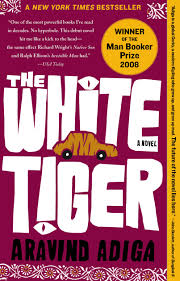The second-person narrator, Balram Halwai, is a boy who wipes tables in a bakery in a poor village in India – a bakery his grandfather once owned but which was seized by a rich person. His father now pedals a rickshaw. Such is the tale of corruption and class oppression this book tells. The poor are like roosters in a coop, so tightly confined to their status for so many generations, they come to accept their lot as destiny, hence the caste system. It’s a dark, hopeless world-view.
Balram can read and write however, and in a series of letters to the prime minister of China, he tells his autobiography. Why that correspondent? No reason. It’s just a literary device to justify the clunky second-person voice. Unlike in The Reluctant Fundamentalist, where the second-person point of view was artistically justified by the narrator’s need to be heard without argument from his powerful listener, in this case, the point of view seems merely a gimmick, and I found it distracting.
Balram vows to escape the darkness of poverty, corruption, and oppression. He finagles a job driving taxis, then being a chauffeur for a wealthy man in the city. He describes his life as a lowly servant in a rich household, treated not unkindly, but with contempt. He has escaped his village but not the rooster coop. There is no escaping the rooster coop. The author describes a grim society with social and economic class differences so institutionalized they do seem like destiny.
Balram does eventually escape the rooster coop by murdering his master, stealing a pile of money, and fleeing to live as a fugitive in a big city, no longer a rooster, now a white tiger. He gets away with it and prospers. The message is: there is no natural way to break out of your social position in India except through radical violence. All other pathways are closed. Successful emotional conveyance of that message is the triumph of the novel.
The bright, sardonic humor of the narrator creates a light tone to contrast with the dark mood of the themes, and that contrast is the best feature of the book. The portrait of hopelessness at the bottom and vapidity at the top is well-painted, though obviously exaggerated.
And exaggeration is the reason why overall, the book is less than perfect. Yes, poverty is awful. Yes, it’s hard to break out of your social class. Yes, corruption is disgusting. But the same could be said of any developing country. The same could be said of America.
To change your social class, the best route is education. There’s also military and government service, and there’s cleverness in commerce, and plain hard work and frugal living. Millions have done it all those ways. Our hero, however, was a drunk, a drug-user, a thrice-convicted jailbird, and a cynical, delusional, sociopathic manipulator. His whining about not being able to catch a break did not garner much sympathy from me, and his violent, criminal solution was not justified.
Yet the character wasn’t bad-ass enough to live a life of crime. He was a docile servant all his life until that decisive day (which was not well-motivated). So he’s neither a noirish anti-hero nor a triumphant everyman. I don’t know what he was. Maybe a white rooster.
Adiga, Aravind (2008). The White Tiger. New York: Simon & Schuster/ Free Press (275pp).

